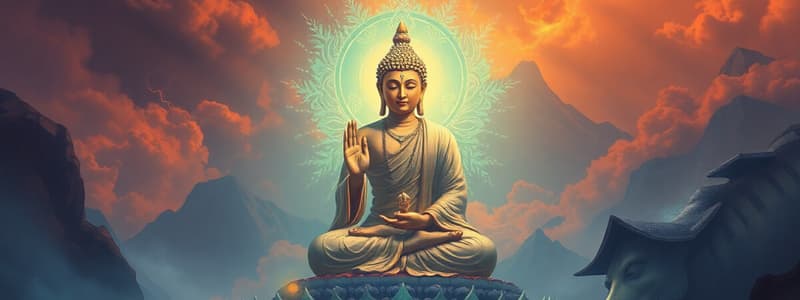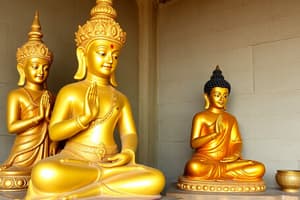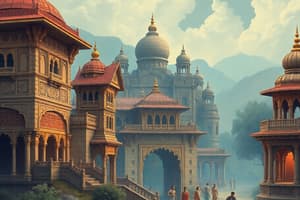Podcast
Questions and Answers
What was the primary trade route that connected India to Rome?
What was the primary trade route that connected India to Rome?
- The Silk Road
- The Indian Ocean Trade Route (correct)
- The Spice Route
- The Trans-Saharan Trade Route
What was the name of the ancient Indian civilization that flourished along the Indus River Valley ?
What was the name of the ancient Indian civilization that flourished along the Indus River Valley ?
- Mughal Empire
- Harrappan Civilization (correct)
- Chola Dynasty
- Gupta Empire
What is the name of the holy book of Hinduism?
What is the name of the holy book of Hinduism?
- The Bible
- The Quran
- The Torah
- The Vedas (correct)
What are the main principles of the Indian caste system?
What are the main principles of the Indian caste system?
What is the name of the famous Indian epic that tells the story of the Pandavas and Kauravas?
What is the name of the famous Indian epic that tells the story of the Pandavas and Kauravas?
What is the meaning of the term 'Satyagraha'?
What is the meaning of the term 'Satyagraha'?
Which of the following is a major religion in India?
Which of the following is a major religion in India?
What was the name of the famous Indian poet and playwright who wrote the play "Shakuntala"?
What was the name of the famous Indian poet and playwright who wrote the play "Shakuntala"?
Which Indian dynasty is credited with the spread of Hinduism and the development of art and literature?
Which Indian dynasty is credited with the spread of Hinduism and the development of art and literature?
What is the significance of the Taj Mahal?
What is the significance of the Taj Mahal?
Which historical factor most significantly contributed to the diverse religious landscape of India?
Which historical factor most significantly contributed to the diverse religious landscape of India?
How did the establishment of trade networks influence cultural exchange in ancient India?
How did the establishment of trade networks influence cultural exchange in ancient India?
Which of the following best describes the role of philosophy in shaping ancient Indian society?
Which of the following best describes the role of philosophy in shaping ancient Indian society?
What was a primary long term consequence of extensive trade for ancient India?
What was a primary long term consequence of extensive trade for ancient India?
How does the concept of dharma influence the social structure in India?
How does the concept of dharma influence the social structure in India?
What aspect of Indian art and architecture best reflects the diverse religious synthesis present in India?
What aspect of Indian art and architecture best reflects the diverse religious synthesis present in India?
Which of the following describes a key characteristic of the bhakti movement?
Which of the following describes a key characteristic of the bhakti movement?
How did geographical features impact the development of early Indian civilizations?
How did geographical features impact the development of early Indian civilizations?
How does the concept of karma most directly influence the ethical actions in traditional Indian society?
How does the concept of karma most directly influence the ethical actions in traditional Indian society?
What best describes the interactions between different religious communities in ancient India?
What best describes the interactions between different religious communities in ancient India?
Flashcards
What is the Brahmi script?
What is the Brahmi script?
A system of writing used in ancient India, known for its beautiful and intricate script, which includes both vowel and consonant sounds.
What is non-violence according to Indian religions?
What is non-violence according to Indian religions?
The practice of non-violence, a core principle of Hinduism, Buddhism, and Jainism, emphasizing peaceful and compassionate living.
What are the Vedas?
What are the Vedas?
A set of religious and philosophical texts in Hinduism, considered sacred and providing guidance on spiritual life, rituals, and ethical conduct.
What was the Golden Age of India?
What was the Golden Age of India?
Signup and view all the flashcards
What is the caste system?
What is the caste system?
Signup and view all the flashcards
What is renunciation?
What is renunciation?
Signup and view all the flashcards
What is Buddhism?
What is Buddhism?
Signup and view all the flashcards
What is Hinduism?
What is Hinduism?
Signup and view all the flashcards
What is Jainism?
What is Jainism?
Signup and view all the flashcards
What is the classical period of Indian history?
What is the classical period of Indian history?
Signup and view all the flashcards
Non-violence
Non-violence
Signup and view all the flashcards
Golden Age of India
Golden Age of India
Signup and view all the flashcards
Caste System
Caste System
Signup and view all the flashcards
Buddhism
Buddhism
Signup and view all the flashcards
Hinduism
Hinduism
Signup and view all the flashcards
Jainism
Jainism
Signup and view all the flashcards
Classical Period of Indian History
Classical Period of Indian History
Signup and view all the flashcards
Vedas
Vedas
Signup and view all the flashcards
Renunciation
Renunciation
Signup and view all the flashcards
Brahmi Script
Brahmi Script
Signup and view all the flashcards
Study Notes
Indian Culture, Religions & Trade
- Hinduism and Buddhism were India's two primary faiths around 250 BCE
- Hinduism is a polytheistic religion, believing in many gods
- Buddhism teaches that suffering is caused by human desires, and that overcoming suffering involves following specific practices to achieve right thoughts, efforts, and actions.
Roots of Buddhism
- Buddhism emphasizes achieving nirvana, a state of perfect happiness and peace
- Nirvana can be achieved through either death or spiritual enlightenment
- The Eightfold Path is a series of practices to help achieve nirvana
Gautama Buddha, The Buddha
- Gautama Buddha, also known as "The Buddha," was a Sramana
- He was a religious figure who dedicated his life to a higher religious purpose and lived around 5th to 4th century BCE
- He was regarded as the Enlightened One, a savior who established a path to release people from desire and a cycle of rebirth.
- He taught for 45 years, and did not want people to worship him. He was born into an aristocratic family, but renounced that luxurious life to build a religious community.
Bodhisattvas
- After Buddha's death, some began teaching that he was a god.
- Others believed that many people could become Buddhas, known as bodhisattvas
- Bodhisattvas postponed achieving nirvana to help others.
The Two Sects
- By the 1st century CE, Buddhists divided into two sects.
- The Mahayana sect adapted a more modern form of Buddhism, incorporating more modern beliefs.
- The Theravada sect held to more traditional teachings and beliefs.
Buddhism Transforms
- New creative expressions in Buddhism emerged, leading to large Buddha statues.
- Wealthy merchants commissioned the construction of stupas, mounded structures built over holy relics.
- Stupas were places of worship for believers.
Hinduism and Priests
- Hinduism developed complex observances primarily performed by priests.
- The average Hindu has less direct connection with the religion.
The Three Gods
- Brahma, creator of the world
- Vishnu, preserver of the world
- Shiva, destroyer of the world
- Vishnu and Shiva became the most popular gods for many Indians.
- This evolution of Hinduism to a more individualistic practice saw its popularity increase.
Changes in Hinduism
- Similar to Buddhism, Hinduism experienced a trend towards monotheism.
- Many people came to believe in a single divine force, even though various gods represent different parts of this force.
Achievements of Indian Culture
- The growth of Hinduism and Buddhism marked a rich period of learning, literature, art, science, and mathematics in India until 500 CE.
Indian Literature and Drama
- Kalidasa (4th-5th century CE), considered India's greatest playwright
- His plays and poetry were based on the Vedas, the ancient religious texts of Hinduism.
- Southern India also played a critical role in the development of India's literary tradition. Kalidasa's plays were celebrated for their beautiful writing and emotional themes.
Astronomy and the Earth
- The growth of trade fueled scientific advancements.
- Sailors used stars for navigation leading to increased knowledge of astronomy.
- Indian astronomers, around 1,000 years before Columbus, realized that the Earth was round by observing a lunar eclipse.
Timekeeping
- Indians adopted a seven-day week and divided the day into hours.
Mathematics and Aryabhata
- India has historically been a key region in the development of mathematics.
- Aryabhata (around 500 CE) calculated the value of pi to four decimal places.
Medicine and Surgery
- Indian physicians during the Common Era could identify and describe over 1,000 diseases.
- They had knowledge of over 500 medicinal plants used as remedies.
- They performed surgery (including plastic surgery) and were early pioneers in injections.
The Spread of Indian Trade
- India had valuable resources like spices, diamonds, and sandalwood.
- Trade with regions as far as Africa began beyond 4000 years ago.
The Silk Road
- India became a part of the trade network known as the Silk Road.
- This network connected East Asia to Western Asia and on to Rome.
Middlemen and Oases
- Indian traders acting as middlemen made significant profits by connecting buyers and sellers.
- Indian traders developed trading stations, particularly at oases, where water was available. This facilitated commerce across vast distances.
Maritime Trade
- Maritime trade using coastal routes expanded, bringing goods from India to Rome and other regions more quickly.
Banking in India
- Banking emerged in India due to increased trade.
- Bankers would lend money to merchants, which led to the concept of interest on loans.
The Effects of Indian Trade
- Trade led to extensive cultural exchange.
- People in other regions adapted Indian traditions in art, architecture, and dance.
- Indian culture significantly influenced regions such as Thailand, Cambodia, and Java.
Trade and Religion
- Indian religions (Hinduism and Buddhism) spread to new regions
- The forms of these religions were adapted and transformed through interaction with other cultures; local cultures often incorporated aspects from foreign religions.
Buddhism (Spread)
- Buddhism spread through traveling monks and merchants along the Silk Road.
- Buddhist scriptures were translated into Chinese, which further influenced the spread of Buddhism.
- Buddhist missionaries played a role in spreading the religion across different cultures.
Studying That Suits You
Use AI to generate personalized quizzes and flashcards to suit your learning preferences.
Related Documents
Description
Explore the essential aspects of Indian culture, focusing on the key religions of Hinduism and Buddhism. This quiz covers the foundational teachings of Buddhism, the life of Gautama Buddha, and the path to achieving nirvana through the Eightfold Path. Test your understanding of these influential faiths and their historical relevance.




